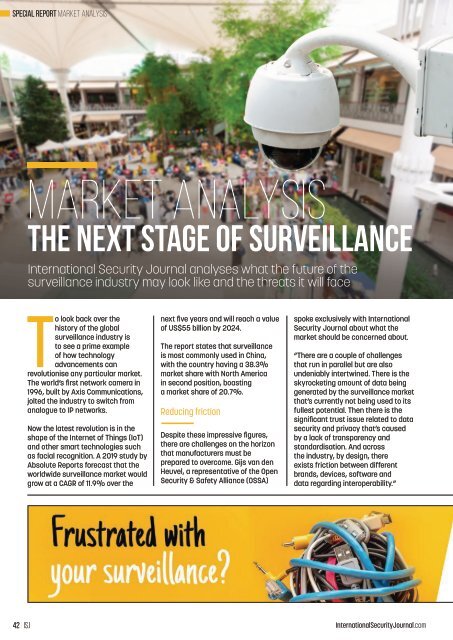International Security Journal - August 2019 - Special Report
Create successful ePaper yourself
Turn your PDF publications into a flip-book with our unique Google optimized e-Paper software.
special report market Analysis<br />
Market Analysis<br />
The next stage of surveillance<br />
<strong>International</strong> <strong>Security</strong> <strong>Journal</strong> analyses what the future of the<br />
surveillance industry may look like and the threats it will face<br />
To look back over the<br />
history of the global<br />
surveillance industry is<br />
to see a prime example<br />
of how technology<br />
advancements can<br />
revolutionise any particular market.<br />
The world’s first network camera in<br />
1996, built by Axis Communications,<br />
jolted the industry to switch from<br />
analogue to IP networks.<br />
Now the latest revolution is in the<br />
shape of the Internet of Things (IoT)<br />
and other smart technologies such<br />
as facial recognition. A <strong>2019</strong> study by<br />
Absolute <strong>Report</strong>s forecast that the<br />
worldwide surveillance market would<br />
grow at a CAGR of 11.9% over the<br />
next five years and will reach a value<br />
of US$55 billion by 2024.<br />
The report states that surveillance<br />
is most commonly used in China,<br />
with the country having a 38.3%<br />
market share with North America<br />
in second position, boasting<br />
a market share of 20.7%.<br />
Reducing friction<br />
Despite these impressive figures,<br />
there are challenges on the horizon<br />
that manufacturers must be<br />
prepared to overcome. Gijs van den<br />
Heuvel, a representative of the Open<br />
<strong>Security</strong> & Safety Alliance (OSSA)<br />
spoke exclusively with <strong>International</strong><br />
<strong>Security</strong> <strong>Journal</strong> about what the<br />
market should be concerned about.<br />
“There are a couple of challenges<br />
that run in parallel but are also<br />
undeniably intertwined. There is the<br />
skyrocketing amount of data being<br />
generated by the surveillance market<br />
that’s currently not being used to its<br />
fullest potential. Then there is the<br />
significant trust issue related to data<br />
security and privacy that’s caused<br />
by a lack of transparency and<br />
standardisation. And across<br />
the industry, by design, there<br />
exists friction between different<br />
brands, devices, software and<br />
data regarding interoperability.”<br />
42 | Isj <strong>International</strong><strong>Security</strong><strong>Journal</strong>.com


